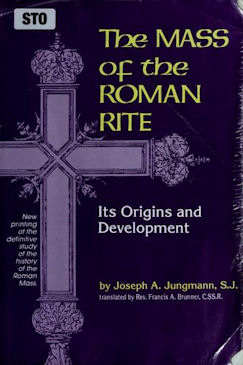
|
Posted
January 13, 2013
Books: The Mass of the Roman Rite: It Origins and Development [2 volumes] Author: Joseph A. Jungmann, S.J. Christian Classics, Ave Maria Press. Notre Dame, IN. 2012 An Excerpt from the Jackets:
An Excerpt from the books: The Our Father But besides the petition for bread there is another passage in the Our Father which receives special stress in its use at Mass. This is the petition for the forgiveness of sins. Even Optatus of Mileve gives this petition promininence above all. Augustine refers to its presence in the Our Father, and asks impressively: "Why is it spoken before the reception of Christ's Body and Blood? For the following reason: If perchance, in consequence of human frailty, our thought seized on something indecent, if our tongue spoke something unjust, if our eye was turned to something unseemly, if our ear listened complacently to something unnecessary. . .it is blotted out by the Lord's Prayer in the passage: Forgive us our debts, so that we may approach in peace and so that we may not eat or drink what we receive unto judgment." For Augustine, the Our Father is like washing the face before the altar. For that reason it was the practice at Hippo for all, priest and faithful, to strike their breast while pronouncing the words, dimitte nobis debita nostra [forgive us our debts]. That the Roman Mass also gave special importance to the final petition introduced by these words, is shown by the supplement, the so-called embolism, which has its counterpart in all the liturgies except the Byzantine. The Table of Contents in both volumes covers every aspect of the Mass in minute detail.
|
|
